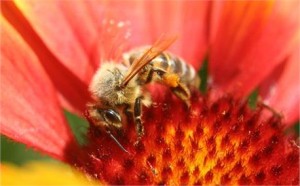
I may be alone, but I couldn’t quite get that honeybee research I meant to write about last week off my mind. Honeybee dancing gets a lot of press, but that’s not the only kind of message they can send. Honeybees can also use scents for signaling. The trick there is that pheromones will become diffuse. Like talking, it’s fine for a chat with your neighbor but not long distance conversations. But sometimes honeybees need to get in touch with their far-flung friends. For example, sometimes a queen needs to gather a swarm to split off a new colony. How does she get the word out?
I think it’s useful to reflect for a moment on how we solve this problem. How do you get a large number of people to assemble? You can pick a time sufficiently far in the future and then wait for invitations to travel to everyone. But bees don’t have calendars, and may not be able to predict the need to swarm far in advance. You can call or text, but for bees there’s no such thing as a phero-phone to translate scents into digital signals that can be encoded in electromagnetic signals to send over long distances at the speed of light. You can also attempt to have your message spread by word of mouth, an informal peer-to-peer solution. “Time to swarm, pass it on.” Based on the observations in this latest study, that’s the closest analogue to what the honeybees actually do. When honeybees detects the swarm signal, they orient themselves in particular patterns and release the same pheromone themselves. They also use their wings to create a local air current to ‘transmit’ the signal farther in a particular direction. This amplifies the message and gets it through the colony quickly.
The news article compares this to the children’s party game “Telephone” where kids sit in a line and whisper a message one to another. The fun of the game (allegedly) comes from hearing how the message gets mangled along the way, through misunderstanding or poor articulation or possibly even deliberate sabotage. (If you enjoy etymology puzzles along with or instead of entomology research, trace back the roots of “phero-phone” to see how my intended wordplay diverges from the original meaning.) I wonder though if “Telephone” is the best analogy. I don’t see`discussion of miscommunication in the paper, and the swarming wouldn’t work if the message drifted the further it traveled from the queen. I wonder if a bucket brigade might get the idea across better. There aren’t the connotations of confusion, but instead a sense of cooperation. True, the honeybees aren’t passing along the same physical molecules, but they are faithfully passing along what they receive. Or maybe there is some level of going off script, but the amplification involved means that the original signal remains the strongest one.
And maybe there’s something in all this honeybee communication chat for our current misinformation woes, but the comparative simplicity of the swarm message probably limits applicability. Instead, check out the simulation videos in the paper. In addition to observing actual honeybees sending swarm signals, the researchers also constructed models of individual bees acting based on local information and no knowledge of the queen’s location. Those simulations demonstrated similar overall results to the real honeybee behavior. As I see it, that kind of constructive understanding is the most compelling, because you aren’t just taking the system apart and identifying individual pieces, you’re also putting something together to see what is required to get the dynamic operation of the whole. And at that point, even if it isn’t a perfect model of honeybee swarming, you’ve built something useful that could be applied and extended elsewhere. Those possibilities are why I find modeling and simulation so exciting.
Andy has worn many hats in his life. He knows this is a dreadfully clichéd notion, but since it is also literally true he uses it anyway. Among his current metaphorical hats: husband of one wife, father of two teenagers, reader of science fiction and science fact, enthusiast of contemporary symphonic music, and chief science officer. Previous metaphorical hats include: comp bio postdoc, molecular biology grad student, InterVarsity chapter president (that one came with a literal hat), music store clerk, house painter, and mosquito trapper. Among his more unique literal hats: British bobby, captain’s hats (of varying levels of authenticity) of several specific vessels, a deerstalker from 221B Baker St, and a railroad engineer’s cap. His monthly Science in Review is drawn from his weekly Science Corner posts — Wednesdays, 8am (Eastern) on the Emerging Scholars Network Blog. His book Faith across the Multiverse is available from Hendrickson.

Leave a Reply